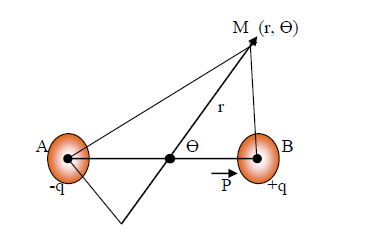Potential (V) at any Point
Description:
We know that potential due to a dipole in axial and equatorial position .We also know the dipole moment is a vector quantity and is direction is from –q to +q , represented as P→ as shown in figure

To calculate potential created by a dipole at any general position ( neither on the axial position nor on the equatorial position):Take a point P in any general point which is at a distance r’ making an angle ‘θ’ with the dipole
All the measurement of distances are to be taken from the centre(O). Which is the mid point of the dipole.
Let the distance between O to +q and O to –q be ‘l’. So, total length between +q and –q will be ‘2l’.
Take a point ‘p’ at the distance ‘r’ from the centre of the dipole as shown in figure.
To calculate potential at point ‘P’ due to the two point charges of dipole.
By using the formula for potential due to point charge.
potential due to +q, V+q = q4πε0 1BM.....(1)
Since, by Pythagoras theorem the distance between P and +q is (r2 + 12)1/2
potential due to -q ,V-q = - q4πε0 1AM
(potential due to +q will be positive and potential due to -q will be negative)
So, the net potential ,V = V1+V2
V = q4πε0 1BM - q4πε0 1AM.........(1)
To concert AM and BM in terms of ‘r’, draw a perpendicular from point ‘A’ on extended ‘r’ and let the intersecting point be Q. Similarly, draw a perpendicular from point ‘B’ on position vector ‘r’ and let the intersecting point be N.
Let the angle between two lines CM and BM be very small ( say approaching to 0), then MB will be approximately equal to NM. So the length CN will give the difference in length of two lines.
In ΔCNB
CNl = Cosθ
⇒ CN = l Cosθ
So, BM = r - l Cosθ
Similarly, AM = r+ l Cosθ
Putting these two in equation (1) We get −
V = q4πε0 1(r - lcosθ)- q4πε0 1(r+lcosθ)
V = q(r+lcosθ - r+lcosθ)4πε0 l(r2 - l2Cosθ)
V = 2qlcosθ4πε0 l(r2 - l2Cosθ)
V = Pcosθ4πε0 l(r2 - l2Cosθ)
If (l≪ r)
Then, neglecting l as compared to r, we get −
V = Pcosθ4πε0 l(r2)
Test
Case(1) For θ = 0(case of point in an axial line);
V = P4πε0 l(r2)
Case(2) For θ = 90(case of point in an equitorial line);
V = 0

